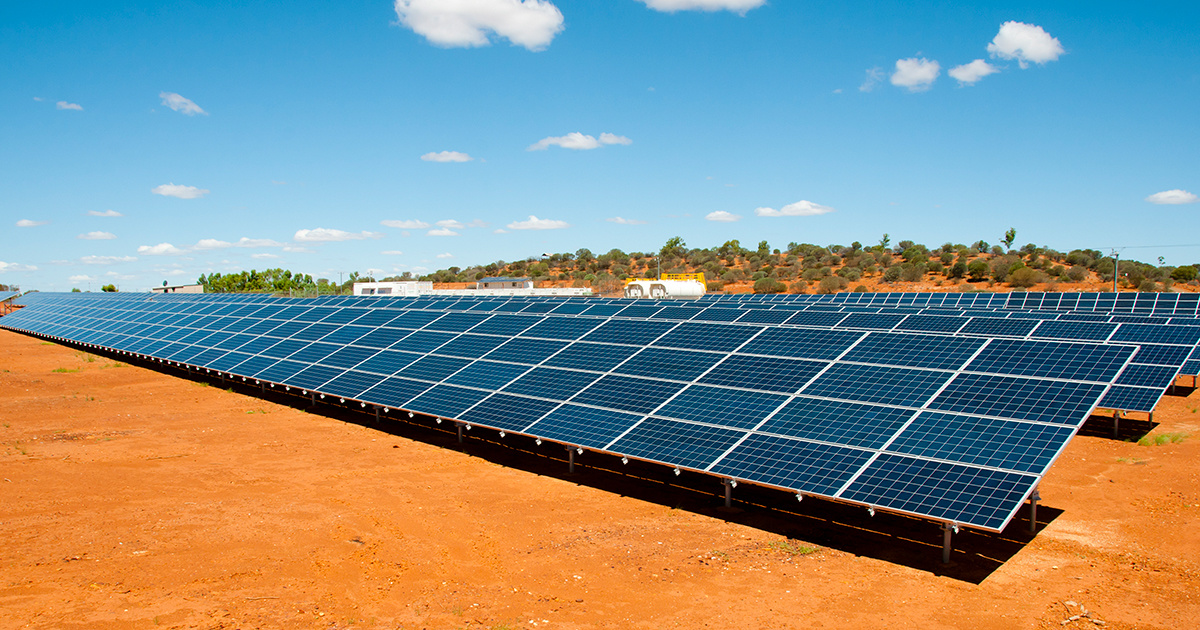

Photon-Photos / iStock / Getty Images Plus
The desert of Australia’s Northern Territory has the iconic Ayers Rock, but not much else. Soon, it may be known as home to the world’s largest solar farm, according to the Guardian.
The massive project outside Tennant Creek will cost about $20 billion and offer a construction boon to solar power developers while also changing the face of Australia’s energy industry.
The current plans for the project, known as Sun Cable, call for a 10-gigawatt-capacity array of solar panels that will spread across 37,000 acres. It will be backed up by battery storage to make sure it can supply power 24-hours a day. Electrical lines will then send the electricity to Darwin, powering the small city at the top of Australia. Yet, the vast majority of the energy will travel through an undersea cable that snakes through Indonesia to Singapore, as the Guardian reported.
The group behind Sun Cable says the solar farm will capture “one of the best solar radiance reserves on the planet” and provide 20 percent of Singapore’s electricity, replacing its gas-fired power.
“It is extraordinary technology that is going to change the flow of energy between countries. It is going to have profound implications and the extent of those implications hasn’t been widely identified,” said David Griffin, managing director of Singaporean developer Sun Cable, as PV Magazine Australia reported. “If you have the transmission of electricity over very large distances between countries, then the flow of energy changes from liquid fuels — oil and liquid natural gas — to electrons. Ultimately, that’s a vastly more efficient way to transport energy. The incumbents just won’t be able to compete.”
Assuming the project passes muster after an environmental review, Sun Cable will start construction in 2023 with commercial operations to start in 2027. The project will employ Australian businesses and personnel and could create thousands of construction and manufacturing jobs in the sparsely populated Northern Territory.
So far, the project has been embraced by the local government and enticed investors, including software billionaire Mike Cannon-Brookes, who is considering involvement through his Grok Ventures private investment firm, according to the Guardian.
The Sun Cable projects follows an equally ambitious project in a dry, dusty part of Western Australia, where developers want to build a hybrid wind and solar plant to power local industries.
“To our knowledge, it’s the largest wind-solar hybrid in the world,” said Andrew Dickson, project developer, at the proposed Asian Renewable Energy Hub, as the Guardian reported.
Furthermore, Indonesia-based Terregra Renewables has successfully commissioned its first Australian based solar farm in Southern Australia, according to Renew Economy.
“This will be the channel through which production of energy in Australia will greatly reduce emissions in the rest of the world. It will also be a foundation for a new era of economic expansion and prosperity,” said Ross Garnaut, chairman of the Australian-German Energy Transition Hub, who champions Australia’s potential as a clean energy leader, as the Guardian reported.
The push toward exporting renewables could help Australia meet its commitment to the Paris climate agreement, which is at risk if it continues its unfettered oil and natural gas exploration, as EcoWatch reported last week. Australia is the currently the world’s biggest exporter of coal and rivals Qatar as the leader in selling liquefied natural gas.
- Singapore Will Plant One Million Trees by 2030 - EcoWatch
- World's Largest Solar Farm to Supply 20% of Singapore's Electricity - EcoWatch

 233k
233k  41k
41k  Subscribe
Subscribe 